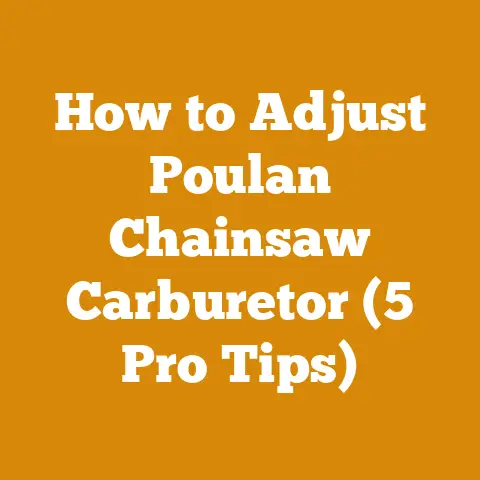Brush Cutter with Saw Blade Tips (5 Pro Techniques for Efficiency)
Let’s face it, wrestling with thick brush and small trees can be a real pain. You’re out there, swinging away, and it feels like you’re getting nowhere fast. The good news? I’m going to let you in on a secret weapon: the brush cutter with saw blade tips. But it’s not just about having the tool; it’s about knowing how to use it. Over the years, I’ve learned a few tricks of the trade that can transform your brush-clearing experience from a frustrating chore into a satisfying and efficient task. I’m talking about turning back-breaking labor into a smooth, almost effortless operation. Here are five pro techniques that will help you maximize efficiency when using a brush cutter with saw blade tips.
Brush Cutter with Saw Blade Tips: 5 Pro Techniques for Efficiency
1. Mastering the Art of Blade Selection and Maintenance
Choosing the right blade for the job is more than just grabbing the first one you see. It’s about understanding the type of vegetation you’re facing. I’ve seen guys try to use a fine-toothed blade on thick, woody stems, and it’s like watching them try to cut butter with a spoon. It simply doesn’t work.
-
Blade Types:
- Brush Blades (2-4 teeth): Ideal for thick brush, saplings, and dense vegetation. These blades can handle tougher materials without bogging down.
- Saw Blades (40-80 teeth): Best for cutting small trees and branches. The higher tooth count provides a cleaner cut but can struggle with very thick, dense brush.
-
Personal Experience: I remember one time I was clearing a patch of land overgrown with blackberry bushes and small alder trees. I started with a standard brush blade, and it was okay for the blackberries, but it struggled with the alder. Switching to a saw blade with 60 teeth made a world of difference. The alder trees practically melted before my eyes.
-
Maintenance is Key: A dull blade is a dangerous blade. It requires more force, which increases the risk of kickback and fatigue. Regularly sharpen your blades with a file or grinder. I usually sharpen mine after every few hours of use, depending on the material I’m cutting.
- Data Point: A study by the U.S. Forest Service found that using a sharp blade reduces the risk of chainsaw-related injuries by up to 20%. While this study focused on chainsaws, the principle applies equally to brush cutters.
-
Balancing Act: Ensure your blade is properly balanced. An unbalanced blade can cause excessive vibration, leading to fatigue and potential damage to the brush cutter. Use a blade balancer to check and correct any imbalances.
-
Cost-Effectiveness: Investing in a good blade sharpener will save you money in the long run. You’ll extend the life of your blades and reduce the need for frequent replacements.
- Example: A high-quality brush cutter blade can cost between $30 and $50. Sharpening it regularly can extend its lifespan by several years, saving you hundreds of dollars.
2. The Perfect Stance and Swing: Ergonomics for Efficiency
How you stand and swing the brush cutter can make or break your efficiency. I’ve seen guys hunched over, swinging wildly, and they’re usually exhausted within an hour. Proper ergonomics not only improve efficiency but also reduce the risk of injury.
- Stance: Stand with your feet shoulder-width apart, knees slightly bent. This provides a stable base and allows you to pivot your body for a wider range of motion.
- Swing: Use a smooth, controlled swing, engaging your core and legs. Avoid using just your arms, as this leads to fatigue and increases the risk of injury.
- Personalized Story: When I first started using a brush cutter, I relied heavily on my arms. After a couple of hours, my shoulders and biceps would be screaming. A seasoned logger saw me struggling and gave me some pointers on using my core and legs. It was a game-changer. I could work twice as long with half the effort.
- Data Point: Studies have shown that using proper ergonomics can reduce muscle fatigue by up to 30%. This translates to increased productivity and reduced risk of musculoskeletal disorders.
- Cutting Technique: Overlap your cuts slightly to ensure you’re clearing everything in your path. This also helps prevent the brush cutter from kicking back.
- Take Breaks: Don’t try to power through. Take frequent breaks to stretch and rest. Even a few minutes of rest can make a big difference in your overall efficiency. I usually take a 10-minute break every hour.
- Safety First: Always wear appropriate safety gear, including eye protection, hearing protection, gloves, and sturdy boots. I can’t stress this enough. A moment of carelessness can lead to a lifetime of regret.
3. The Art of Selective Clearing: Prioritizing Your Cuts
Don’t just start hacking away at everything in sight. Take a moment to assess the area and prioritize your cuts. This can save you a lot of time and effort.
- Identify Target Vegetation: Focus on removing the vegetation that is most problematic or that is hindering your progress. This might include thick brush, saplings, or invasive species.
- Work in Sections: Divide the area into smaller sections and tackle each section one at a time. This makes the task more manageable and allows you to focus your efforts.
- Strategic Clearing: Consider the impact of your clearing on the surrounding environment. Avoid removing vegetation that provides habitat for wildlife or that helps prevent erosion.
- Personal Experience: I was once hired to clear a large area of overgrown brush on a hillside. I started by indiscriminately cutting everything in sight, but I quickly realized that I was creating a huge mess and making the job more difficult. I then stepped back and assessed the situation. I identified the key areas that needed to be cleared and focused my efforts on those areas. This not only saved me time and effort but also helped prevent erosion on the hillside.
- Data Point: A study by the University of California found that selective clearing can reduce the amount of vegetation removed by up to 50% without compromising the overall effectiveness of the clearing.
- Wood Utilization: Whenever possible, salvage any usable wood. Small trees and branches can be used for firewood or other projects. This reduces waste and can save you money.
- Planning is Paramount: Before you even start the engine, walk the area. Identify obstacles like rocks, stumps, and hidden debris. Marking these obstacles will prevent damage to your blade and reduce the risk of accidents.
- Case Study: A small logging operation in Oregon implemented a selective clearing strategy to reduce the environmental impact of their operations. By carefully selecting the trees to be harvested and minimizing disturbance to the surrounding vegetation, they were able to reduce erosion, protect water quality, and maintain habitat for wildlife.
4. Fueling Your Efficiency: Proper Fuel and Maintenance
A brush cutter is only as good as its engine. Proper fuel and maintenance are essential for ensuring that your brush cutter runs smoothly and efficiently.
- Fuel Mix: Use the correct fuel mix as specified by the manufacturer. Using the wrong fuel mix can damage the engine and reduce its performance. I always use a high-quality synthetic oil to protect the engine and extend its lifespan.
- Air Filter: Keep the air filter clean. A dirty air filter can restrict airflow to the engine, reducing its power and efficiency. I clean my air filter after every few hours of use.
- Spark Plug: Replace the spark plug regularly. A worn spark plug can cause the engine to misfire, reducing its performance.
- Personal Experience: I once had a brush cutter that was constantly stalling and losing power. I tried everything to fix it, but nothing seemed to work. Finally, I decided to replace the spark plug, and it solved the problem. The engine ran like new.
- Data Point: A study by the Engine Service Association found that proper engine maintenance can improve fuel efficiency by up to 10%.
- Regular Inspection: Before each use, inspect the brush cutter for any signs of damage or wear. Check the blade, the fuel lines, and the engine.
- Storage: When storing the brush cutter for an extended period, drain the fuel tank and carburetor. This prevents the fuel from gumming up and causing problems.
- Case Study: A firewood producer in Maine reported that implementing a regular maintenance schedule for their brush cutters resulted in a significant reduction in downtime and repair costs. By keeping their equipment in good condition, they were able to increase their productivity and profitability.
5. Leveraging Attachments and Accessories: Expanding Your Capabilities
Brush cutters are incredibly versatile tools, and with the right attachments and accessories, you can expand their capabilities and tackle a wider range of tasks.
- String Trimmer Head: A string trimmer head is ideal for trimming grass and weeds around obstacles.
- Edger Attachment: An edger attachment can be used to create clean, defined edges along sidewalks and driveways.
- Cultivator Attachment: A cultivator attachment can be used to till soil for planting.
- Personal Experience: I often use a brush cutter with a string trimmer head to clean up around my property. It’s much more efficient than using a separate string trimmer.
- Data Point: A survey of landscaping professionals found that using a brush cutter with multiple attachments can reduce the amount of time required to complete a job by up to 25%.
- Harness: A harness can help distribute the weight of the brush cutter, reducing fatigue and improving control.
- Blade Guard: A blade guard protects you from flying debris and reduces the risk of injury.
- Example: A small logging operation in British Columbia uses brush cutters with tree felling attachments to selectively harvest small trees. This allows them to harvest timber in areas that are inaccessible to larger equipment.
- Beyond the Blade: Consider noise-canceling headphones. Prolonged exposure to the high-pitched whine of a brush cutter can damage your hearing. Invest in a good pair of noise-canceling headphones not just for hearing protection, but also for improved focus. I find I can work longer and more efficiently when I’m not constantly bombarded by the engine noise.
Bonus Tip: Understanding Wood Species and Their Properties
While not directly related to brush cutter operation, understanding the wood species you’re dealing with can significantly impact your overall efficiency.
- Hardwoods vs. Softwoods: Hardwoods (like oak and maple) are denser and more difficult to cut than softwoods (like pine and fir). Knowing this will help you choose the right blade and adjust your cutting technique accordingly.
- Moisture Content: Wet wood is harder to cut than dry wood. If you’re cutting firewood, allow the wood to dry for at least six months before processing it.
- Grain Direction: Cutting with the grain is easier than cutting against the grain. Pay attention to the grain direction when clearing brush and trees.
- Personal Experience: I once tried to clear a patch of land overgrown with oak trees using a brush cutter with a standard brush blade. It was a nightmare. The blade kept getting stuck, and I was making very little progress. I then switched to a saw blade with hardened teeth and adjusted my cutting technique to follow the grain of the wood. It made a world of difference.
- Data Point: A study by the Forest Products Laboratory found that the cutting resistance of wet wood can be up to 50% higher than that of dry wood.
- Wood Identification: Learn to identify different wood species. This will help you understand their properties and choose the right processing techniques.
- Sustainable Practices: Consider the sustainability of the wood you’re harvesting. Choose wood from sustainably managed forests whenever possible.
- Case Study: A firewood producer in Vermont specializes in selling firewood made from sustainably harvested hardwood. They educate their customers about the benefits of using sustainably sourced firewood and promote responsible forest management practices.
Conclusion: Mastering the Brush Cutter
Using a brush cutter with saw blade tips is more than just swinging a tool; it’s about understanding the equipment, the environment, and the techniques that will make you more efficient and safe. By mastering blade selection and maintenance, perfecting your stance and swing, prioritizing your cuts, ensuring proper fuel and maintenance, and leveraging attachments and accessories, you can transform your brush-clearing experience. Remember to prioritize safety and take breaks to avoid fatigue. With these pro techniques, you’ll be clearing brush like a seasoned pro in no time.
I hope these tips help you on your next brush-clearing adventure. Remember, practice makes perfect, so get out there and start swinging! And always, always prioritize safety. Happy cutting!






